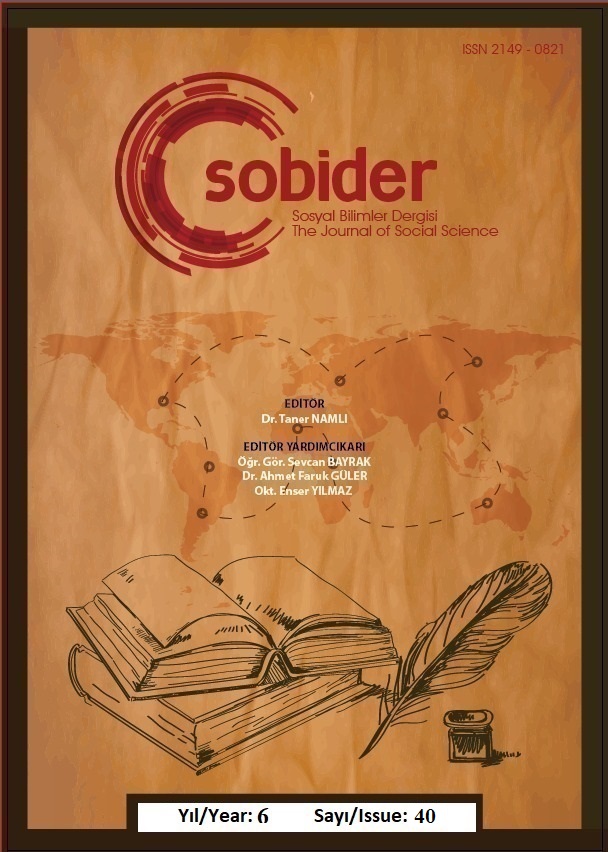Author :
Abstract
Bu çalışma; engelli bireylerin, dışlanma kavramı kapsamında medyada nasıl edildikleri üzerine yoğunlaşmıştır. Engellik ve dışlnma kavramları, englliğin giderek arttığı günümüz toplumlarında büyük bir önem arz etmektedir. Bu noktada, engelli bireylerin konumu yerel ve evrensel açıdan kritik hale gelmektedir. Bu açıdan bakıldığında; medyanın, kitleleri yönlendiren bir gücü olduğuna ve bu güç ile, toplumun normları ve engellilik kavramını birleştirdiğine dikkat etmek gerekir. Bu görüşler dikkate alındığında, bu çalışmanın temelini engellilik kavramı ve ayrımcılık algısının oluşturacağı anlaşılabilir. İlgili örnekleme dair gözlem ve bulgular, bu bağlamda değerlendirilecektir. Çalışmanın örneklemi, Türk Dizisi “Öyle Bir Geçer Bir Zaman Ki” ile sınırlandırılmıştır. Tüm bu değerlendirmelerin, Türkiye’de engelli bireylerin konumlandırılması yönünde bizlere ışık tutması planlanmaktadır.
Keywords
Abstract
This study focuses on the way in which the identity of the persons with disabilities situated in the media in the context of discrimination. The concept of disability and discrimination is highly important in a world that the numbers of persons with disabilities keep increasing. Specially, the standing point of persons with disabilities in societies is very critical both at global and local levels. Herein, it is important to mention the fact that the media has the power to determinate the audience. It combines the norms of society with the understanding of disability. By taking into consideration of these discussions, the concepts of disability and discrimination will be basis of this study. Then, the observation and findings in the related sample were evaluated. The sample of article is limited with one Turkish Drama Serial; “Öyle Bir Geçer Zaman Ki” (Times Goes By So Fast). All of these evaluations lead us to understand the positions of persons with disabilities in Turkey.
Keywords
- Aytekin, E. P. (2018). An Example of Orientation A Women Identitiy in Indigenious TV Serial: "Yaprak Dökümü". Erciyes İletişim Dergisi, 447-463.
- Barnes, C. (2003). Effecting Change; Disability, Culture and Art. Liverpool: Liverpool Institute for the Performing Arts . Cauchi, D. Stand-up Comedy and Disability: a paradox or a means to an end. Malta: University of Malta.
- Conderelli, R. (2016). Social complexity, modernity and suicide: an assessment of Durkheim’s suicide from the perspective of a non-linear analysis of complex social systems.
- Davis, L. (1988). The End of Identity Politics: On Disability as an Unstable Category. L. Davis
- Davis, L. (1995). Enforcing Normalcy. New York: Verso.
- EtilÈ, F. (2007). Social Norms, Ideal Body Weight and Food Attitudes. JournÈes des Economistes de la SantÈ Français.
- Fairclough, N. (2001). Language and Power. New York: Routledge.
- Garland-Thomson, R. (2002). Integrating Disability, Transforming Feminist Theory. NWSA, 1- 32.
- Hodwitz, O., & Frey, K. (2016). Anomic suicide: A Durkheimian analysis of European normlessness. Sociological Spectrum, 236-254.
- Jackson, R., McAfee, J., & Cockram. (1999). Dısabılıty Dıscrımınatıon In Educatıon.Joondalup: Edith Cowan University.
- Jin, K. K., & Lee, Y. G. (2013). Anomic or Egoistic Suicide: Suicide Factors among Malaysian Youths. International Journal of Social Science and Humanity, 47-51.
- Laki, I. (2014). The concept of discrimination nowadays. Struktúrafordulók. Studies in Political Science - Politikatudományi Tanulmányok (s. 252-259). içinde Budapest: MTA TK Politikatudományi Intézet.
- Linton, S. (1998). Claming Disability: Knowledge and Identity. New York: New York University Press.
- Maskill, C., Hodges, I., McClellan, V., & Collings, S. (2005). Explaining Patterns of Suicide A selective review of studies examining social, economic, cultural and other populationlevel influences. New Zealand : Ministery of Health.
- Meltzer, H., Brugha, T., Dennis, M. S., Hassiotis, A., Jenkins, R., McManus, S., . . . Bebbington, P. (2012). The Influence of Disability on Suicidal Behaviour. ALTER, European Journal of Disability Research, 1-12.
- Michailakis, D. (2003). The Systems Theory Concept of Disability: One is not born a disabled person, one is observed to be one. Disability & Society , 209-229.
- Müller, F., Zoonen, L. v., & Klijn, M. (2012). Disability, prejudice and reality TV: Disablism through media representations. Telecommunications Journal of Australia, 62.
- Oliver, M. (1994). Politics and Language: Understanding the Disability Discourse. London:University of Greenwich.
- Puar, J. K. (2012). The Cost of Getting Better: Suicide, Sensation, Switchpoints. GLQ, 149-158. Rights, C. f. (2015). Suicide Prevention and Assisted Suicide. New York: CDR.
- Rohwerder, B. (2015). Disability Inclusion: topic guide. Birmingham: Governance and Social Development Resource Centre.
- Serpa, S., & Ferraira, C. M. (2018). Anomie in the sociological perspective of Émile Durkheim.
- Soykan, Ö. (2013) Yerli Tv Dizilerinde İktidar İlişkileri: Dizi Karakterlerinin Benlik Sunumları Üzerinden Bir Analiz. Ege University: İzmir.
- Siebers, T. (2001). Disability in Theory: From Social Constructionism to the New Realism of the Body. American Literary History, 737-754.
- Unıcef. (2011). The right of children with disabilities to education: A rights-based approach to
- Wendell, S. (1989). Toward A Feminist Theory of Disability. Hypatia, 104-121.
- WHO. (2011). Work and Employement. World Health Organization.
- Willmore, L. (1997). Discrimination . New York: United Nations Department of Economic and Social Affairs .
- Wilson, J. C. (2002). (Re)Writing the Genetic Body-Text: Disability, Textuality, and the Human Genome Project. Cultural Crituque, 23-29.
- Yumurtacı, D. (2012). Predictors of Body Image Among University Students. Istanbul: Middle East Technical University.
